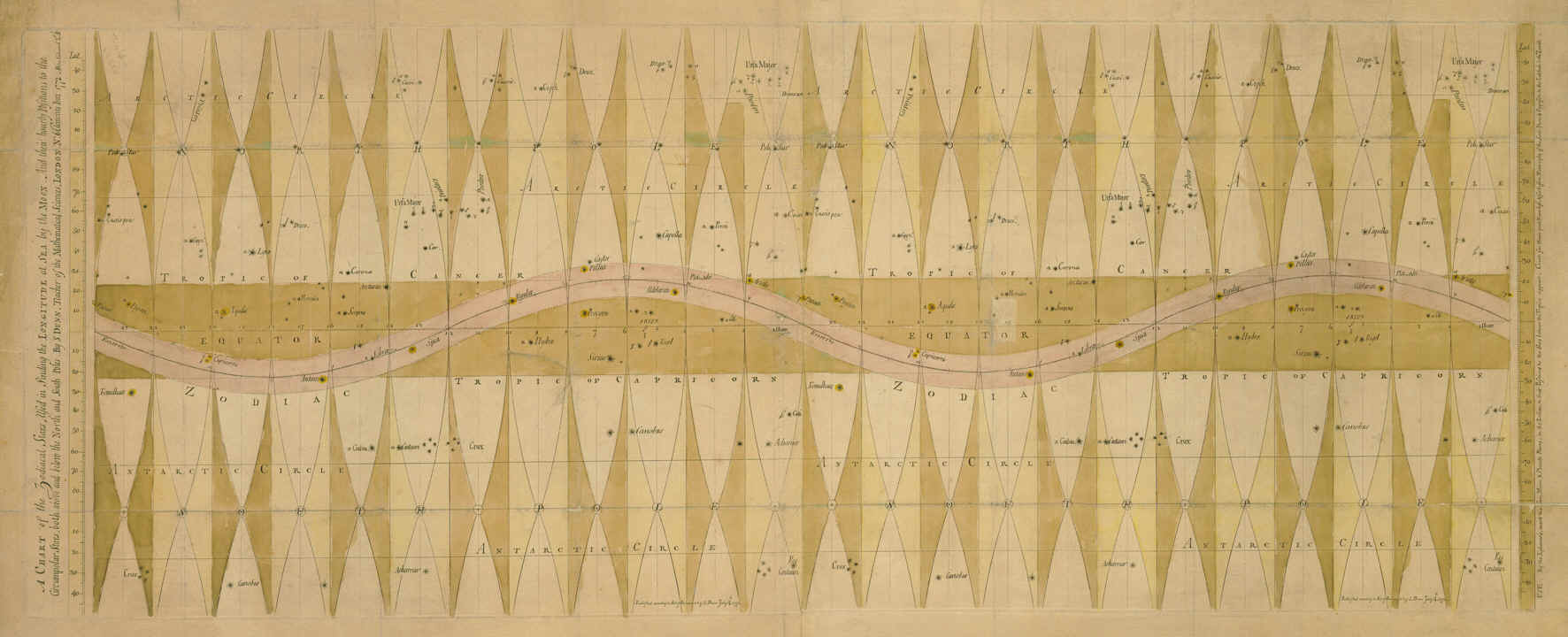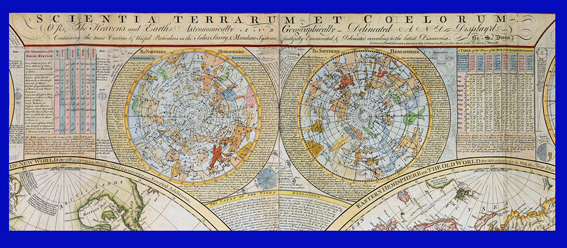
|
Samuel Dunn |
The Description and Use of the Universal Planispheres; or, Terrestrial and Celestial Globes in Plano, London 1759
|
Samuel Dunn
The Description and Use of the Universal Planispheres; or, Terrestrial and Celestial Globes in Plano, London 1759

Attraverso l’uso di quattro tavole piane in proiezione stereografica convessa l’autore spiega al suo lettore l’uso semplificato a due dimensioni del globo celeste e di quello terrestre. Una quinta tavola propone un reticolo che una volta sovrapposta a quelle terrestri o celesti permette di calcolare la posizione di un qualsiasi punto venga considerato.
Ripropongo le tavole e la descrizione del volume per cortesia di
https://www.bada.org/object/universal-planisphere
The Description and Use, of the Universal Planispheres; or terrestrial and celestial globes in plano…
Author: DUNN, Samuel
Publication place: London
Publisher: W. Owen, at Homer’s-Head, near Temple-Bar, Fleet Street
Publication date: 1759.
Physical description: 8vo (230 by 140mm), licence fleet, title, five large fold-out plates, original quarter calf over blue paper boards, rubbed and scuffed.
Notes
Samuel Dunn’s rare work on
his invention: the universal planispheres.
Samuel Dunn (d.1794) was a British mathematician and astronomer, and was at the
forefront of developments in navigation and cartography over the eighteenth
century. He was an authorised signatory for ship’s masters’ certificates, a
consultant to the East India Company, and had instruments and publications
accepted by the Board of Longitude.
The ‘Universal
Planispheres’ was published after he had become master of an academy in Chelsea
which specialised in “navigation
and commerce”. Dunn produced a pamphlet on the subject in 1757, and expanded on
it and reissued it as this work.
The book provided “an economical method of teaching spherical geometry without the expense of purchasing actual globes”. The work contains several planispheres — two dimensional maps of the terrestrial and celestial globes on what he called a ‘stereographic’ projection, mimicking the visual and mathematical properties of globes. There are two celestial and two terrestrial plates, with an eastern and western hemisphere of each.
The planispheres are accompanied by a “slider”, which would be used on a planisphere in order to make calculations. Dunn was passionate about navigational education, and his work is an example of the fever gripping Britain as the longitude race continued.
He was a proponent of the use of magnetic variation in order to ascertain longitude at sea, and he is mentioned several times in the minutes of the Board of Longitude between 1765 to 1772 (now housed at Cambridge University). Both the eastern and western planispheres within the present work contain the lines of magnetic variation, and on pages 152 and 153, Dunn deals with the problems of solving longitude at sea using magnetic variation.
Dunn’s book is rarely offered as a complete work, and the plates have often been
extracted. There are two institutional examples in the British Library and
Bibliotheque Nationale de France. The Bodleian holds a copy of the
1757 pamphlet.
L’intero testo può essere consultato ai seguenti indirizzi:



https://archive.org/details/b30541475/page/n133/mode/1up
Le tavole









Dello stesso autore esamina anche
The Principal Fixed Stars Of the North Hemisphere Delineated on the Plan of the Equator for the Year 1774. By S. DUNN, Teacher of the Mathematical Sciences.
The Principal Fixed Stars Of the South Hemisphere Delineated on the Plan of the Equator for the Year 1774. By S. DUNN, Teacher of the Mathematical Sciences.
A chart of the zodiacal stars, used in finding the longitude at sea by the Moon. And their hourly positions to the circumpolar stars, both above and below the north and south poles. London 1772

http://www.atlascoelestis.com/dunn%201772.htm
Scientia terrarum
et coelorum, Chelsea
1772

http://www.atlascoelestis.com/dunn.htm
di FELICE STOPPA
MARZO 2023
